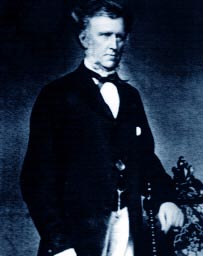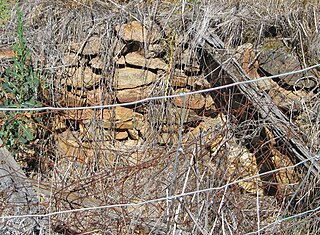
Toodyay Manor on Stirling Terrace was originally the Newcastle Hotel in Toodyay, Western Australia.

Freemasons Hotel, now Toodyay Hotel, is a historic building on Stirling Terrace in Toodyay, Western Australia. It was built for William Tregoning, and originally licensed in 1861 as the Newcastle Hotel. The building was classified by the National Trust, and is listed on both the Register of the National Estate and the Australian Heritage Database.

West Toodyay was the original location of the town of Toodyay, Western Australia. It is situated in the Toodyay valley, 85 kilometres (53 mi) north east of Perth. The Toodyay valley, discovered by Ensign Robert Dale in 1831, was opened up for settlement in 1836. The original site for the town of Toodyay was determined in 1836 and its boundaries were finalized 1838. The first survey of the town was carried out in 1849. After several serious floods, the decision was made to move the town of Toodyay to higher ground. In 1860, the new town of Newcastle was established 3 miles (4.8 km) further upstream. Newcastle was renamed in 1910 to Toodyay, and the original site became known as West Toodyay.
Owen Hackett (1809–1862) was one of a number of Enrolled Pensioner Guards (EPGs) that came to the Swan River Colony between 1850 and 1868. Their role was to guard and oversee the work of the prisoners transported to Western Australia.
Francis Kirk was one of a number of Enrolled Pensioner Guards (EPGs) who came to the Swan River Colony between 1850 and 1868, to guard and oversee the work of the prisoners transported to Western Australia.
David Gailey (1807–1881) was one of a number of Enrolled Pensioner Guards (EPGs) who came to the Swan River Colony between 1850 and 1868. Their role was to guard and oversee the work of the prisoners transported to Western Australia.
Toodyay pioneer heritage trail was a trail created by the Toodyay Bicentennial Community Committee in 1988 for the Australian Bicentenary as part of the W.A. Heritage Trails Network.

The Queen's Head was a hotel in West Toodyay in Western Australia in the latter half of the 19th century.

In 1851, the Toodyay Convict Hiring Depot was set up in the original township of Toodyay, now called West Toodyay. Temporary accommodation for the Enrolled Pensioner Guards was also constructed and surveys were carried out to enable more permanent accommodation to be built close by. The Enrolled Pensioner Guards were men who had either completed their duty of service or who had sustained injury while on active service. They had then volunteered as guards on the ships transporting convicts to Western Australia. Once the men were released from permanent duty, other duties of a peace keeping or military nature were expected of them. Many of these men became warders in charge of convicts.

Toodyay Gaol stood on lot R66, close to the first Convict Hiring Depot, in the original townsite of Toodyay, now known as West Toodyay, in Western Australia. Although generally referred to as a gaol, it was technically a lock-up, holding prisoners only until they were brought before the resident magistrate.

An area in West Toodyay, Western Australia, was gazetted as a Class C Reserve, for water and public utility purposes from 1898 to 1992. A stone-lined well at 31.52281°S 116.42579°E, positioned on what was originally lot R76, exists to this today. It is, however, no longer in use. The well is close to the boundary with what was originally lot R1 on which a spring once arose and flowed into the Avon River. It is very likely that the well had supplied water for a long time, possibly during the 1850s, the days of the convict hiring depot and The Queen's Head hotel.

The Toodyay Valley School was the first government school in Toodyay. It opened on 1 October 1855 with 55 children enrolled. Boarders were received on moderate terms.

The Church of Sancta Maria was the first Roman Catholic church built in the original townsite of Toodyay in Western Australia. It was consecrated in 1859, and served as church, priest's residence, and schoolhouse for the Toodyay Valley Catholic School. It later housed the Toodyay Valley government school.
James Forbes (1828-1906) was an Enrolled Pensioner Guard who had arrived in the Swan River Colony in Western Australia aboard Pyrenees on 28 June 1851. Formerly a private of the 77th Regiment, he was 23 years of age. Soon after he was stationed at Toodyay, his pension expired and he was dismissed. A request for reinstatement was denied him. For a while, Forbes earned a living as a carter.

Sam Ferguson's cottage was built in the latter part of the 1800s on lot R12 in the original town of Toodyay, now known as West Toodyay, Western Australia. Its walls were whitewashed and its roof was thatched. Roses, almond trees and a flurry of old English flowers produced such a wonderful display that artists from all around flocked to paint it. The cottage was the home of Samuel Ferguson and his wife Ellen. It was situated on what was originally Toodyay town lot R12 on the west corner of River Terrace and what is now called Cottage St. On the opposite corner stood the old buildings of John Herbert's Royal Oak inn.

The Royal Oak, established in 1849, was the first inn set up within the original townsite of Toodyay in Western Australia. The relatively modest building was owned by William Herbert and stood on lot R28. Most inns established in the 1840s were simple cottages where a spare room or two had been put aside for use by guests. Although Herbert had applied for lot R28 in 1845, it was not officially granted until after the first survey of the township had been carried out in 1849. His publican's license, however, was granted in July 1849.

The Royal Oak established in 1853 by John Herbert was the second inn of that name in West Toodyay. It was also known as Herbert's Hotel. It stood on lot R11, upstream from where the first Royal Oak had been until it closed in November 1851.

Everett's Cottage is the only remaining building from the original township of old Toodyay, now known as West Toodyay, in Western Australia. Situated in North Street on the three-acre allotment of Suburban Lot 1, it stands immediately behind the site of the former Queen's Head Hotel. Suburban Lot 1 was registered to James Everett on 3 July 1860.
Construction of the new Toodyay Convict Hiring Depot began in February 1852 and was completed by 1856. The depot was closed in 1872. The site chosen, Avon Location 110, was an area of Crown land measuring just over 45 acres (18 ha). It was situated approximately 3 miles (4.8 km) upstream from the site of the previous Toodyay Convict Hiring Depot (1851) located at the Toodyay townsite. The previous depot had only ever been a temporary arrangement born of necessity when accommodation was required at short notice. The new depot site was surveyed by Francis Thomas Gregory in 1852.

The Russell Hotel is a heritage-listed hotel located at 143–143a George Street, in the inner city Sydney suburb of The Rocks in the City of Sydney local government area of New South Wales, Australia. It was built in 1887. It operated as the Port Jackson Hotel until being delicensed in 1923, after which time a new Port Jackson Hotel was built further along George Street. In 1933, it became the Russell Private Hotel, providing accommodation from the upper floors. The ground floor has been leased for various uses since the original delicensing, initially as a cafe for several decades and most recently as a restaurant and bar. The property is owned by Property NSW, an agency of the Government of New South Wales. It was added to the New South Wales State Heritage Register on 10 May 2002.















